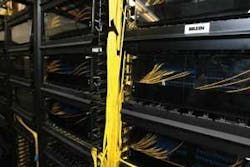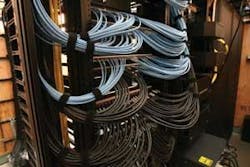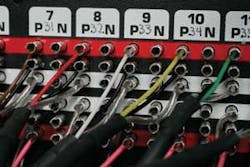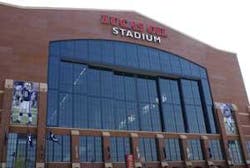Laying the infrastructure for a major league installation
The new home of the NFL’s Indianapolis Colts–and many other entertainment events–required everything from integrated networking to sophisticated audio/visual controls, retractable roof automation, and safety systems.
Lucas Oil Stadium, the new $720 million multi-purpose home of the NFL Indianapolis, features seating for 63,000 fans, two massive scoreboards each with HD-quality video displays, large ribbon board and a uniquely designed retractable roof with moving panels that open from sideline-to-sideline. Windows on each end of the building open as well.
One of the challenges in the planning and design of the stadium’s network and communications system was the sheer size of the structure, as well as the fact that it will be much more than a standard football stadium. It will also be used to host a variety of year-round events ranging from NCAA basketball tournaments to concerts, conventions, meetings, and other public gatherings.
Belden’s state-of-the-art cabling systems were chosen to support the stadium’s integrated networking, data/voice communications, audio/video, CATV, and building management systems. The facility also features a New Generation cabling solution encompassing fire alarm, access control and security systems.
HKS Architects (www.hksinc.com), specialists in sports and entertainment facilities, selected Wrightson, John- son, Haddon & Williams, Inc. (WJHW; www.wjhw.com) of Dallas to design, specify, and coordinate installation of the stadium’s electronic systems (networking and telecom infrastructure, voice/data communications, broadcast and audio/video systems).
Teaming up for success
To handle the installation of the networking, communications, and A/V cabling systems, WJHW selected Indianapolis-based ERMCO/Sachs, a joint venture partnership formed by Sachs Electric Company of St. Louis (www.sachsco.com), and ERMCO, Inc. (www.ermco.com). The two Belden Certified System Vendor (CSV) organizations combine their resources to pursue major construction projects in the Indianapolis area.
Gary Wesselmann, senior project manager for Sachs Electric, notes: “By combining the strengths of both our companies, including technical/engineering and project management expertise, executive management, financial resources, and a deep bench of highly skilled field technicians, we have built a winning team that ensures a well-executed and successful installation.”
Gene Burcham, ERMCO-Sachs’ director of communications, who is responsible for oversight of the entire project on the local front, adds: “In projects of this size and scope, collaboration and teamwork are essential elements of success. The ERMCO/ Sachs joint venture and ongoing service and technical support from Belden enable us to provide clients with added business value, as well as top quality products and heightened productivity and accountability.”
According to Wesselmann, coordination of the cabling systems configuration with other trades within each discrete quad or level of the stadium was relatively simple. “More challenging, however, was the installation of cable pathways and conduit and long cable runs across quad/level boundaries,” he notes. “Because these were more difficult to plan and execute, they required careful forethought and close coordination to avoid any conflicts with other trades requiring similar pathways.”
null
Networking and telecommunications
Belden’s IBDN structured cabling system, which includes fiber and copper media, is designed in a standard star topology. Configuration highlights for the stadium installation include:
- For the data backbone, approximately 30,000 feet of FiberExpress singlemode tight buffer fiber-optic distribution cables (24-strand, 12-strand and 6-strand constructions, both plenum and riser types). The backbone links the Main Equipment Room with more than 50 Telecommunications Rooms, A/V amplifier rooms, and other locations throughout the facility.
- Nearly 1 million feet of MediaTwist Category 6 UTP (CMP) cable installed from the Telecommunications Rooms to approximately 2,500 telecom outlets serving more than 4,500 data termination points.
- For the voice backbone, a copper-based system comprised of 25-, 50-, and 100-pair Category 3 UTP cables (CMP and CMR).
- FiberExpress rack-mount patch panels (4U and 2U), patch cords (SC-LC singlemode duplex), adapter strips, and Optimax connectors.
- Copper connectivity products that include CAT6+ patch panels (2U/48-port), CAT5E patch panels (1U/24-port and 2U/48-port), and CAT6+ modular cords in various colors, and in lengths from 7 to 36 feet. Additional components include 110 crossconnect kits, MediaFlex faceplates, and KeyConnect modular jacks.
- Cable management racks and enclosures, vertical and horizontal cable management solutions, and accessories.
- Backbone pathways consist of cable trays deployed on the event level, lower suite, and press level, along with 3- and 4-inch conduit to provide completed pathways to every telecom closet termination point. In areas open to the public view, all horizontal cabling pathways utilize conduit supported by J-hooks above accessible ceilings.
Broadcast and A/V systems
Highlights of the new stadium’s integrated broadcast and A/V systems include approximately 64,000 feet of FiberExpress singlemode tight buffer fiber-optic distribution cables; Optimax single-mode connectors; more than 400,000 feet of low-loss serial digital coax, plus more than 300,000 feet of broadband CATV coax; large quantities of audio and speaker cable, audio snake cable, instrumentation and control cables, composite camera cables, and underground RG-6 video and audio cable.
SMATV (Satellite Master Antenna Television) cabling and outlets are wired in a star topology using Belden RG-6 cables from the telecom closets. SMATV refers to a system that uses multiple satellite and broadband signals to create a single integrated cable signal for distribution to a cabling network. In the Lucas Oil Stadium system, primary signal distribution is provided via the telecommunication system’s singlemode fiber backbone.
The entire A/V system is controlled from the press level and utilizes amplifier racks distributed throughout the facility, also connected via single-mode fiber-optic cable. Four amp rooms, one in each quad of the building, are located on the mechanical mezzanine level and are used to power the main speaker clusters and the large delay speakers supported by the building structure.
The broadcast cabling system interconnects the main TV and ENG (Electronic News Gathering) rooms, field broadcast cable boxes, outdoor pedestals, and press level locations, using various configurations of copper, fiber, coax and SMPTE cabling.
Sachs’ Wesselmann and ERMCO’s Burcham report that, upon completion of the cabling installation, the electronics systems were tested and performed to industry standards as well as Belden’s stringent technical and performance specifications. Having met these criteria, Belden and the two CSVs were able to issue IBDN Certification: a 25-year Product Warranty and a Lifetime Application Assurance Program.
In addition to the entire networking structured cabling system and audio/video cabling infrastructure installed by the ERMCO/Sachs team, Lucas Oil Stadium also incorporates solutions for safety and security that required an add- itional 300,000 feet of Belden cabling, installed by other Indiana-based electrical contractors. They include New Generation fire alarm, access control, and security system solutions.
A super solution
ERMCO’s Burcham notes, “Perhaps the crowning achievement, as the project was being completed, was the announcement that Indianapolis will host Super Bowl XLVI in 2012. This is not only a testament to our city, but also an acknowledgement of Lucas Oil Stadium as a world-class venue for sporting events.”
Wesselmann of Sachs Electric adds, “This installation was a powerful three-way partnership, with both our companies having a strong relationship with Belden as a preferred cable and connectivity solutions supplier. Working together, we were able to implement a first-class solution.”
STEVE LAMPEN is multimedia technology manager for Belden (www.belden.com).
Overview of Lucas Oil Stadium
Lucas Oil Stadium is situated to showcase its prime Indianapolis location. Its large, wide-angle windows highlight a view of the downtown skyline and the imposing, yet stately brick design and construction are a good fit with the city’s traditional Midwest architectural heritage.
Sitting on a 39-acre site, the stadium has a 12-acre footprint, four entry gates, a 2-level retail store, 58 concession stands, 137 upscale hospitality suites, four sideline club lounges and a 200-seat club lounge overlooking the south end zone. In addition, it houses an exhibit hall, press room, club lounges, lobbies, meeting rooms, offices, mezzanine, and other private areas to house mechanicals, electricals, electronics, security and building systems control.
The stadium’s construction plan was organized on the basis of four quads and six levels, which include, from bottom to top:
- Event Level
- Club Level
- Street Level
- Upper Suite Level
- Lower Suite Level
- Terrace Level
Now complete, Lucas Oil Stadium will ultimately play an integral role in the Indiana Convention Center’s $275-million expansion, expected to be completed by 2010.






